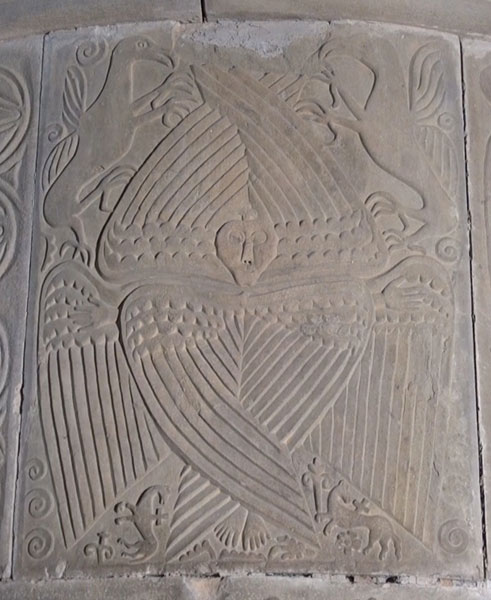THE SERAPH PANEL
The next panel to the left shows a seraph that fills almost all of the space, with two griffins above on either side and two small Agnus Dei below; spiral and plant motifs fill the few empty spaces, the horror vacui being typical of Lombard style. The very flat relief, as we have seen, is also a distinctive characteristic of this art, which according to recent studies has acquired an importance more historic than ethnic, including works, like the pulpit of Gropina, realised after the effective fall of the Lombard reign in 774. This large seraph, exceptional in that its hands and feet are visible, represents divine love, but also the fervour of devotion: seraphim are the purest of the angels, of the nine angelic choirs they are those closest to the throne of God, easily recognizable for their three pairs of wings. They are described thus by Isaiah in his vision of the throne of the Lord: "Each had six wings; with two he covered his face, and with two he covered his feet, and with two he flew " (Book of Isaiah, 6, 2). The Agnus Dei is the symbol of Christ, while the significance of the two griffins in this panel has given rise to various interpretations: guardians or overseers according to don Valente Moretti (2004) or else the double nature of God, human and divine, the hypothesis made by Fornasari (2005). The griffin is a fantastic creature with the head and claws of an eagle and the body of a lion, and, in heraldry, with wings. It combines in itself the powers of these two animals and assumes the functions of vigilance as a guardian of treasures. For Christianity it symbolizes evil, persecution, and also the devil who carries off damned souls. Only later, with Dante, was it to become the mirror of the double nature of Christ and of the role of the pope with temporal and spiritual power. In the panel of Gropina, therefore, the griffins could have a negative significance opposed to the purity of the seraph to whom man must look to reach salvation. The position between two rampant griffins, recalling that of the serpents in the panel with the man and the siren, could have the same meaning -- that of deceit; or the griffins may represent the persecutors of the Christians: in the paliotto of Sigualdo (8th century) two birds bearing a bunch of grapes in their beaks plant their feet on the wings of two griffins, alluding perhaps to the Eucarest (the grapes) vanquishing sin (the griffins).

